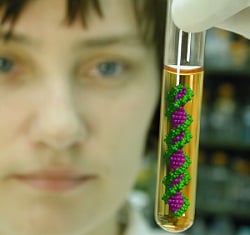Question:
What is the work of salt, isopropanol and ethanol in DNA extraction?
The Protein Man Says:
To identify bacteria and viruses in an environmental sample, diagnose disease pathologies, or examine a biological sample for forensic purposes, the DNA can be removed from the nucleus of a cell and its proteins can be separated by electrophoresis. Salt, isopropanol and ethanol are commonly used to precipitate DNA.
 DNA Extraction from Blood and Other Cell Tissue: Initial Phase
DNA Extraction from Blood and Other Cell Tissue: Initial Phase
The DNA extraction process begins with the mechanical separation of the nuclear contents from the rest of the cell, which is carried out by sonication, agitation and the addition of SDS detergents. To further break down cell components and then draw off the DNA associated proteins, researchers typically add ammonium, sodium acetate or similar salts during this stage of the procedure.
DNA Extraction Using Ethanol Precipitation
Since DNA is insoluble in ethanol and isopropanol, the addition of alcohol, followed by centrifugation, will cause the DNA proteins to come out of the solution. When DNA concentration in the sample is heavy, the addition of ethanol will cause a white precipitate to form immediately. If the DNA concentration in the sample is low, isopropanol may work better than ethanol to precipitate the available proteins. In addition, isopropanol is often used for precipitating DNA from large volumes as less alcohol is used (see protocols below).
The ethanol and isopropanol can also wash away the remaining salt residue. After being washed in alcohol and subjected to a centrifuge, the precipitated DNA protein will form a pellet, which can be washed in alcohol again, dried, and re-suspended in a Tris or TE buffer. Be careful not to overdry the sample, since this can denature the DNA; just leave the washed pellet on the lab table for a few minutes. If isopropanol has been used during the extraction instead of ethanol, the sample may not adhere as tightly to the tube and may require a longer drying time.
General Protocol for Ethanol Precipitation
-
Add 1/10 total volume of Sodium Acetate (3M, pH 5.2).
-
Add 2-3X volume of at least 95% ethanol. Calculate after addition of sodium acetate.
-
Incubate on ice for 15 minutes. In case of small DNA fragments or high dilutions overnight incubation gives best results.
-
Centrifuge at >14,000 x g for 30 minutes at 4°C to prevent overheating the sample.
-
Discard supernatant by decanting or pipetting, being careful not to throw out DNA pellet which may or may not be visible.
-
Rinse with 70% Ethanol and centrifuge at >14,000 x g for 15 minutes at room temperature or 4°C.
-
Discard supernatant, air dry pellet (5-20 minutes) and dissolve pellet in desired buffer.
General Protocol for Isopropanol Precipitation
-
Add 1/10 total volume of Sodium Acetate (3M, pH 5.2).
-
Add 0.6-0.7X volume of room temperature isopropanol. Calculate after addition of sodium acetate. Room temperature isopropanol minimizes coprecipitation of salt.
-
Immediately, centrifuge at >14,000 x g for 30 minutes at 4°C to prevent overheating the sample.
-
Discard supernatant by decanting, being careful not to throw out DNA pellet which may or may not be visible. Isopropanol precipitated pellets are often difficult to see and loosely attached. Mark outside of tube before centrifugation for easy identification.
-
Rinse with 70% Ethanol and centrifuge at >14,000 x g for 15 minutes at room temperature or 4°C.
-
Discard supernatant, air dry pellet (5-20 minutes) and dissolve pellet in desired buffer.






